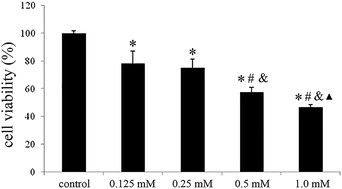Activation of Nrf2/ARE signaling pathway attenuates lanthanum chloride induced injuries in primary rat astrocytes†
Abstract
Lanthanum (La) exposure can lead to learning and memory disorder in animals; however, the underlying mechanism of La induced neurotoxicity is still unknown. It has been demonstrated that Nrf2 activation by tert-butylhydroquinone (tBHQ) results in neuroprotection against brain injuries. However, little study has been done with respect to its effect on La induced neurotoxicity. Herein, experiments are undertaken to determine if there is a correlation between La damaged astrocytes and the Nrf2/ARE signalling pathway. Primary rat astrocytes are exposed to 0 mmol L−1, 0.125 mmol L−1, 0.25 mmol L−1 and 0.5 mmol L−1 lanthanum chloride (LaCl3) for 24 hours. The results reveal that LaCl3 increases the apoptosis/necrosis rate of astrocytes, decreases the glutathione (GSH) content, increases reactive oxygen species (ROS) levels and significantly down-regulates Nrf2 as well as the mRNA and protein expression of Nrf2-regulated genes, including NADP(H): dehydrogenase quinone 1 (NQO1), hemeoxygenase-1 (HO-1), superoxide dismutase 2 (SOD2), glutathione peroxidase 1 (GSH-Px1), glutathione-s-transferase (GST) and γ-glutamine cysteine synthase (γ-GCS) in astrocytes. In addition, it is found that tBHQ displays an antagonistic effect on astrocytes damaged by LaCl3. Therefore, La damaged astrocytes are possibly related to the down-regulated Nrf2/ARE pathway, and treatment with tBHQ clearly activates the Nrf2/ARE signalling pathway, which exerts protection against oxidative stress.



 Please wait while we load your content...
Please wait while we load your content...